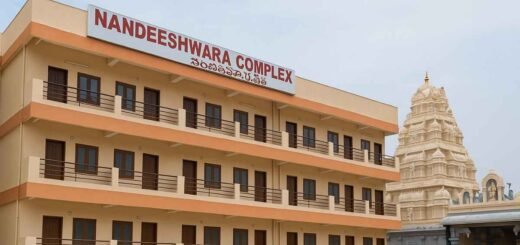Simhachalam Darshan Time Cost Location Procedure
Know the details about Simhachalam Darshan Time Cost Location Procedure, Simhachalam Darshan Time Cost Location Procedure Details
The darshan hours at the Simhachalam temple are as follows: 7:00 am to 4:00 pm and then once again from 6:00 pm to 9:00 pm. Tickets may be purchased at the temple ticket counter; however, there is no possibility of making online reservations for pujas at this time. The cost of a special darshan is one hundred Indian rupees (INR) per devotee.
The price of the ticket for a single person to participate in the Suprabhata Seva at the Simhachalam Temple is Rs. 30. Morning timings for free darshan at the Simhachalam Temple are from 6:30 AM to 11:30 AM. This is known as the Sarva Darsanam. Visits to the Simhachalam Temple in Visakhapatnam do not need payment of an admission charge.
Contents
Simhachalam Darshan Time Cost Location Procedure
There is a Hindu temple in Visakhapatnam, Andhra Pradesh, called the Sri Varaha Lakshmi Narasimha temple at Simhachalam. This religious establishment is also known by the names Sinhachala and Simanchala. It is located on the Simhachalam Hill Range, which is 300 meters above sea level. It is devoted to Lord Vishnu, who is venerated there in the form of the deity Varaha Narasimha. According to the tale that is associated with this temple, Vishnu took on this appearance (the head of a lion and the body of a human) after preventing his disciple Prahlada’s father, Hiranyakashipu, from carrying out an attempt to kill Prahlada.
The idol of Varaha Narasimha is coated in sandalwood paste throughout the year, with the exception of Akshaya Trutiya. This gives it the appearance of a linga and is done in honor of the Hindu festival Akshaya Trutiya. The current temple was constructed in the 13th century in Odisha by King Langula Narasingha Deva I of Eastern Ganga, and it was dedicated by the King’s son, Bhanudeva I, in 1268 AD. The temple was designed in the style of Kalinga architecture.
Important religious destinations, the state of Andhra Pradesh is home to 32 Narasimha temples, of which Simhachalam is one among them. Together with Srikurmam and the Jagannath Temple at Puri, it was considered to be a significant center of Vaishnavism throughout the medieval era. The oldest inscription at the temple dates back to the 11th century CE and records the donation of the temple by a private person during the reign of Chola monarch Kulottunga II.
The second oldest inscription is a contribution that was made by the ruler of the Eastern Ganga Kingdom in Odisha, Anantavarman Chodaganga Deva. This is the first tribute from the Royal family to the ancient temple of Simhachalam, which was built in the 11th century CE. Before this, the temple had only received gifts from private individuals. Under the reign of Narasingha Deva I, who erected a new temple, the temple complex went through a period of time in which it experienced significant physical alterations. These renovations occurred in the latter part of the 13th century.
History Of The Temple
The history of the Simhachalam temple dates back about a thousand years. Epigraphers unearthed around five hundred inscriptions inside the compound of the temple. Donation records, also known as dana sasanas, accounted for almost all of the documents in question. These documents detailed the donations that had been given by the monarchs, their officials, and the citizenry. The vast majority of the inscriptions are written in both Sanskrit and Telugu, although the majority of them are bilingual.
The majority of the inscriptions are written in Sanskrit, but there are also 46 written in Odia and three written in Tamil. An inscription made by the Chola monarch Kulottunga I in the 11th century CE is the primary reason why historians agree that the Simhachalam temple was known and visited by the public at that time. The oldest inscription found in the temple, it dated back to the 11th century and was unearthed in 1087 CE. It belonged to the 11th century. It made a note of a private individual’s donation of a garden to the institution. During this time period, the temple was able to operate well because to the generous support of the Later Chola kings.
Simhachalam Darshan Time Cost Location Procedure And Details
Following in the footsteps of the Later Cholas, the Eastern Ganga dynasty extended their support to the temple complex in order to further its development and ensure its continued preservation. The dates on their inscriptions span from 1150 to 1430 after the common era. Under the reign of Narasimhadeva I, the temple complex was subjected to significant alterations to its physical appearance in the latter part of the 13th century. The temple, which had an unpretentious and understated appearance overall, received a number of new architectural additions throughout time.
An inscription that was placed in the temple in the year 1293 CE mentions the addition of three sub-shrines that were dedicated to different manifestations of Vishnu by the Gangas. These manifestations were Vaikunthanatha, Yagnavaraha, and Madhavadevara. The builders recycled as many of the original slabs as they could but ended up having to throw away a few of them. Those who were removed were afterward put to use in the kitchen and many other humble sanctuaries. The feudatory chiefs of the Ganga dynasty also gave contributions and offerings of different kinds to the construction of the temple.
Click here to find Simhachalam Darshan Time Cost Location Procedure
Click here to know more about Tiruchendur Mandapam Booking Cost Procedure Application
This is the complete details about Simhachalam Darshan Time Cost Location Procedure.


